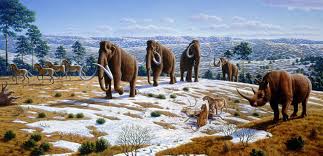Can't say exactly when people first started living in India. The earliest known Indian man has been found near Hathnora village near Hoshangabad in Madhya Pradesh. It was not possible to accurately diagnose this time. It is estimated that it will be 1 million years old. No written description of the prehistoric period is available. Because then people did not know how to write. Only their equipment and weapons can be learned from them. Archaeologists have termed this age as the 'Stone Age' since humans used to manufacture machinery using stones. The stone age has been further divided into three parts, namely, (1) the Palaeolithic Age or the Old Stone Age, (2) the Mesolithic Age or the Middle Stone Age, and (3) the Neolithic Age or New Stone Age.
Palaeolithic Age or Old Stone Age
The evolution of the old age has been around for a long time. Approximately 3,000 years ago, that is, the ancestral era ended in 5 BCE. At that time, people did not know how to cultivate. They were on the way; Split into small groups and move around. Their main diet was the fruit and animal flesh of the tree. People were collectors of food at that time. The farmers did not know how to produce or produce crops. They used different types of stone weapons for animal hunting. The excavations of the Ganges, Jamuna and Indus valley have been found in various places throughout India. Of these, the hand axe was the most important. Hand axes have been found in the Swan River basin in western Punjab.Middle Ages [Mesolithic Age or Middle Stone Age]
The Middle Ages in India lasted from about 3 BCE to 1 BCE. However, in other places outside India, this era is missing. In those places, the new era began directly after the flood. Even during this time, people were food collectors, not food producers. Because even then people did not learn to cultivate. However, this time the weapons of the stone become smaller in size. The weapons of this period are called microliths; That is, it is small, tough and, in most cases, triangular. People also become proficient in pottery and painting. The Vimbetkar cave in Madhya Pradesh is a notable painting of the period.Neolithic Age or New Stone Age
Given the regional disparities, it is arguably the beginning of the Neolithic era in India from around 3 BC. During this time, people controlled agriculture and livestock and became food producers. Therefore, people gradually evacuate and start living permanently. Learning to build houses with clay and bamboo. The textile weaving industry is evolving. Dead art is flourishing. Weapons and equipment are much better, smoother and stronger than ever. People also become perfect in the use of fire. The civilization of this era in Mehergarh.Read Also
Why is India Called Bharat || How Bharat Became India
Introduction of Geographical Features of India in History
Classification of ethnic groups in India on the basis of Languages
Basic Concept of unity in diversity in India
Sources of Ancient Indian History
Main Sources of Medieval Indian History
Ancient India
Archive.org





0 Comments